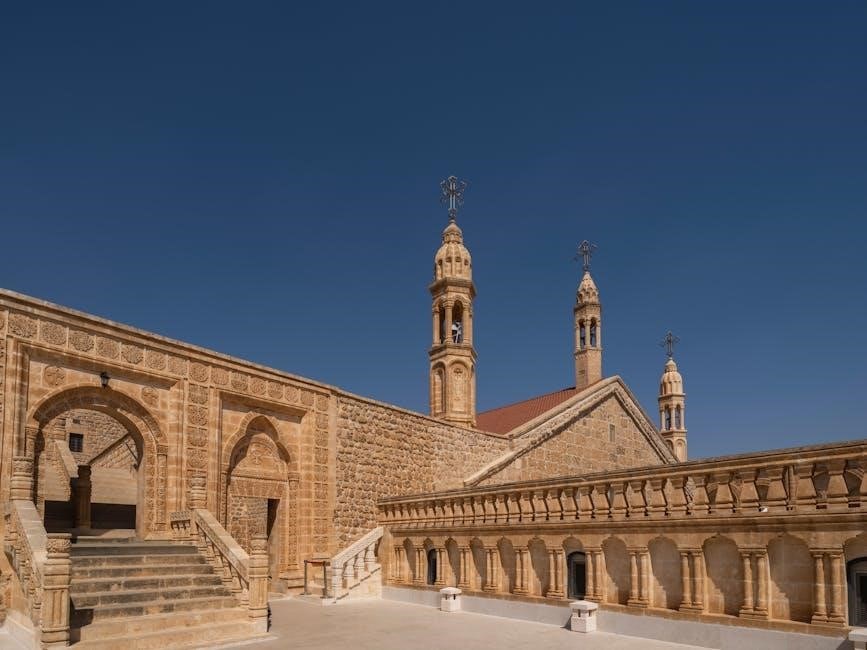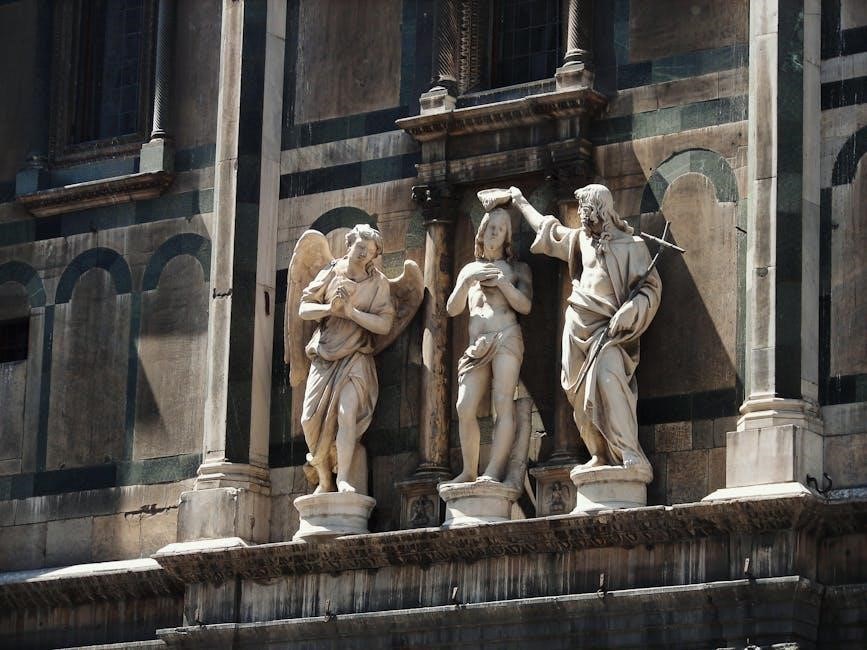seeing jesus in the old testament pdf
- by leo

The phenomenon of Seeing Jesus in the Old Testament reveals God’s master plan of salvation‚ emphasizing the Bible’s unity and Christ’s central role in Scripture.
1.1. The Concept of Christ in the Old Testament
The Old Testament contains numerous references to Christ‚ often through types‚ prophecies‚ and symbols that foreshadow His life‚ death‚ and resurrection. These elements reveal God’s redemptive plan‚ with Christ as the ultimate fulfillment. From the promises to Abraham to the sacrifices and rituals‚ the Old Testament points to a future Messiah. The concept of Christ in the Old Testament strengthens faith by demonstrating God’s consistent and cohesive plan of salvation. This understanding deepens worship and praise‚ as it highlights the unity of Scripture and Christ’s central role in history.
1.2. The Importance of Biblical Unity
Recognizing Jesus in the Old Testament highlights the Bible’s unity‚ revealing it as a single‚ cohesive narrative centered on Christ. This understanding strengthens faith and deepens worship‚ showing God’s plan unfolding consistently across both Testaments. By seeing Jesus in the Old Testament‚ believers gain a fuller appreciation of Scripture’s interconnectedness‚ reinforcing the belief that every part of the Bible points to Him. This unity underscores the relevance and authority of the entire Word of God‚ providing a foundation for trust and transforming how we read and apply Scripture in our lives.

1.3. Overview of Key Themes and Symbols
The Old Testament is rich with themes and symbols that point to Jesus Christ‚ such as the Promised Seed‚ sacrificial lambs‚ and divine redemption. These elements highlight God’s plan of salvation‚ showcasing Christ as the fulfillment of Old Testament promises. Types like Adam and Moses prefigure Jesus‚ while prophecies and symbolic events‚ such as the Passover‚ foreshadow His sacrifice and resurrection. Understanding these themes and symbols deepens the connection between the Testaments‚ illustrating how every part of Scripture ultimately points to Jesus‚ the Messiah and Savior of humanity.
Methods of Seeing Jesus in the Old Testament
Uncover Christ through typology‚ prophecy‚ and symbolism. These methods reveal Jesus as the fulfillment of Old Testament shadows‚ predictions‚ and representations‚ showcasing His divine plan and purpose.
2.1. Typology: Jesus as the Fulfillment of Old Testament Types
Typology involves studying Old Testament “types” or prefigures that foreshadow Jesus. These include people‚ events‚ and institutions that symbolize aspects of Christ’s life and mission. For example‚ Adam prefigures Jesus as the “Second Adam‚” bringing life through resurrection. The Passover Lamb symbolizes Christ’s sinless sacrifice‚ while Melchizedek represents Christ’s eternal priesthood. These types reveal God’s redemptive plan‚ demonstrating how Jesus fulfills Old Testament shadows. Understanding typology enriches biblical unity and highlights Christ as the ultimate revelation of God’s promises and redemption. It bridges the Testaments‚ showcasing Jesus as the climax of salvation history.
2.2. Prophecy: Messianic Predictions
Messianic prophecies in the Old Testament provide direct predictions about Jesus’ life‚ death‚ and resurrection. These predictions‚ often made centuries beforehand‚ highlight God’s plan of redemption. Isaiah 53 describes the Messiah’s suffering and sacrifice for sin‚ while Micah 5:2 identifies Bethlehem as His birthplace. Psalm 22 foretells crucifixion details‚ and Zechariah 9:9 predicts His triumphal entry into Jerusalem. These prophecies‚ fulfilled in Jesus‚ demonstrate divine foreknowledge and confirm His identity as the Messiah. Studying these predictions deepens faith and underscores the Bible’s unity‚ revealing Jesus as the ultimate fulfillment of Old Testament expectations.
2.3. Symbolism: Objects and Events Pointing to Christ
The Old Testament is rich with symbolic objects and events that prefigure Christ. The bronze serpent‚ lifted by Moses‚ symbolizes salvation through Christ’s crucifixion. The tabernacle’s furnishings‚ like the Ark of the Covenant‚ represent God’s presence‚ fulfilled in Christ. Sacrificial lambs and the Passover symbolize Christ’s atoning death. These symbols‚ embedded in Israel’s history‚ reveal God’s redemptive plan‚ preparing His people for the Messiah. By interpreting these symbols‚ believers gain deeper insights into Christ’s mission and the unity of Scripture‚ enriching their faith and appreciation for biblical cohesion.

Key Old Testament Figures and Their Connection to Jesus
Old Testament figures like Adam‚ Noah‚ Abraham‚ and Moses serve as prototypes‚ foreshadowing Jesus’ ministry and sacrifice. Their lives and roles point to Christ’s redemptive plan.
3.1. Adam: The First Adam and the Second Adam
Adam‚ the first man‚ represents humanity’s original state of innocence and the introduction of sin through disobedience. Jesus‚ as the “Second Adam‚” restores humanity through obedience and redemption. Paul in Romans 5 and 1 Corinthians 15 contrasts Adam’s sin with Christ’s righteousness‚ emphasizing that just as death came through Adam‚ life comes through Jesus. This typology highlights Jesus as the ultimate solution to humanity’s fallen condition‚ fulfilling God’s redemptive plan.
3.2. Noah: Salvation Through Faith
Noah’s story illustrates salvation through faith and obedience‚ serving as a precursor to Jesus’ redemptive work. Noah obeyed God‚ building an ark to save his family and creatures from judgment. This act of faith mirrors Jesus’ sacrifice‚ offering salvation to humanity. The ark symbolizes God’s grace‚ providing refuge from sin’s flood. Just as Noah’s faith led to deliverance‚ belief in Jesus brings eternal salvation. This typology underscores the theme of divine rescue and the necessity of faith in God’s plan‚ linking Noah’s obedience to Jesus’ ultimate redemption.
3.3. Abraham: Father of Faith and Promise
Abraham‚ as the father of faith‚ exemplifies trust in God’s promises‚ prefiguring Jesus’ role as the ultimate fulfillment of these promises. God’s covenant with Abraham‚ promising a numerous descendants and blessings‚ points to Christ‚ who extends these blessings universally. Abraham’s willingness to sacrifice Isaac reflects his unwavering faith‚ symbolizing God’s sacrifice of His Son for humanity’s redemption. Paul highlights Abraham as a model of faith in Romans 4‚ emphasizing justification through faith alone. This connection underscores Jesus as the true heir of Abraham’s promises‚ making Abraham’s story a rich tapestry of Christological significance and redemptive history.
3.4. Moses: The Prophet and Redeemer
Moses‚ as a prophet and redeemer‚ foreshadows Christ’s ministry. He led Israel out of slavery‚ symbolizing spiritual redemption through Jesus. Moses mediated God’s covenant‚ prefiguring Jesus as the ultimate mediator. His intercession for Israel mirrors Christ’s advocacy for believers. Moses’ role in establishing worship and sacrificial systems points to Jesus’ fulfillment as the perfect sacrifice. The tabernacle’s design‚ overseen by Moses‚ symbolizes Christ’s presence among His people. Moses’ humility and leadership qualities reflect aspects of Jesus’ character. Thus‚ Moses’ life and ministry serve as a rich typological representation of Jesus‚ the true Prophet and Redeemer.

Key Old Testament Events and Their Significance
Key Old Testament events‚ such as Creation‚ the Exodus‚ and the Passover‚ symbolize redemption and foreshadow Christ’s ultimate sacrifice‚ revealing God’s divine plan progressively.
4.1. Creation: The Foundation of God’s Plan
Creation‚ as depicted in Genesis‚ serves as the cornerstone of God’s redemptive plan‚ establishing His sovereignty and purpose. Through Creation‚ God set the stage for humanity’s relationship with Him. The act of creating mankind in His image highlights God’s intention for fellowship and dominion. The account also introduces themes of order‚ life‚ and redemption‚ foreshadowing Christ’s role as the Creator and Redeemer. Jesus‚ as the Word‚ was present at Creation‚ emphasizing His divine nature and central role in God’s plan. The seventh day’s rest symbolizes the ultimate rest believers find in Christ‚ linking Creation to redemption.
4.2. The Passover: A Shadow of Christ’s Sacrifice

The Passover‚ instituted in Exodus‚ is a profound symbol of Christ’s sacrifice. The lamb’s blood on doorposts spared Israel’s firstborn‚ prefiguring Christ’s blood saving believers from spiritual death. The lamb had to be without blemish‚ mirroring Christ’s sinless nature. The Passover meal’s elements‚ like unleavened bread and bitter herbs‚ symbolize Christ’s body and the bitterness of sin. Crucified during Passover‚ Jesus fulfilled this shadow‚ offering eternal redemption. The Passover commemorates deliverance and serves as a metaphor for spiritual deliverance through Christ‚ pointing to the New Covenant sealed by His blood‚ offering eternal redemption and a deeper relationship with God.
4.3. The Exodus: Deliverance and Redemption
The Exodus‚ Israel’s deliverance from Egyptian slavery‚ foreshadows Christ’s redemptive work. God’s mighty acts‚ like parting the Red Sea‚ demonstrate His power to save. The wilderness journey symbolizes believers’ pilgrimage toward eternal life. Christ‚ as the true Deliverer‚ frees humanity from spiritual bondage to sin. The Exodus narrative highlights God’s faithfulness and grace‚ mirrored in Christ’s sacrifice. This event serves as a powerful reminder of divine redemption‚ pointing to Jesus as the ultimate Savior who leads His people into eternal inheritance and freedom from sin’s slavery through His victorious work on the cross.
The Importance of Studying Jesus in the Old Testament
Studying Jesus in the Old Testament strengthens faith‚ reveals God’s unified plan‚ and deepens worship by showing Christ as the fulfillment of all Scripture‚ enriching spiritual understanding.
5.1. Strengthening Biblical Unity
Studying Jesus in the Old Testament reveals the seamless connection between the testaments‚ showcasing Christ as the fulfillment of every promise and prophecy. This unity deepens understanding of God’s plan‚ emphasizing that the entire Bible‚ from Genesis to Revelation‚ centers on Jesus. Recognizing Him in the Old Testament strengthens the coherence of Scripture‚ dispelling fragmentation and enriching one’s view of God’s redemptive work. This unified perspective transforms Bible study from disjointed stories into a harmonious narrative of Christ’s glory‚ ultimately fostering a deeper appreciation for the divine authorship of all Scripture;
5.2. Deepening Worship and Praise
Recognizing Jesus in the Old Testament enriches worship by unveiling the depth of God’s redemptive plan. Seeing Christ as the fulfillment of symbols‚ types‚ and prophecies inspires awe and gratitude‚ fostering a deeper connection to His divine work. The unity of Scripture‚ with Jesus as its center‚ transforms worship into a celebration of God’s consistent and loving nature. This revelation ignites heartfelt praise‚ as believers comprehend the profound significance of Christ’s sacrifice and reign‚ drawing them closer to the heart of God and enriching their devotion.
5.3. Enhancing Evangelism and Apologetics
Recognizing Jesus in the Old Testament provides a powerful tool for evangelism and apologetics. It demonstrates the unity of Scripture‚ offering compelling evidence of God’s plan of redemption. By showing how Old Testament prophecies‚ types‚ and symbols point to Christ‚ believers can share the gospel with clarity and confidence. This approach also equips apologists to address questions about the Bible’s coherence and Jesus’ divine identity. Highlighting these connections strengthens the case for Christianity‚ making the message of salvation more persuasive and accessible to seekers and skeptics alike‚ while deepening understanding of God’s redemptive work across history.
5.4. Promoting Personal Spiritual Growth
Seeing Jesus in the Old Testament fosters deeper spiritual growth by revealing the continuity of God’s redemptive plan. It enhances personal faith by showing how Jesus is the ultimate fulfillment of Old Testament promises and types. This study invites believers to reflect on God’s faithfulness‚ encouraging trust and obedience. By tracing Christ’s presence throughout Scripture‚ individuals gain a richer understanding of His character and work‚ leading to a more intimate relationship with Him. This transformative insight cultivates a heart of worship‚ gratitude‚ and devotion‚ empowering believers to live out their faith with greater purpose and surrender.

Practical Application of Old Testament Revelations
Applying Old Testament insights involves personal reflection‚ communal study‚ and integrating Christ-centered truths into daily life‚ fostering a deeper walk with God and transformative spiritual growth.
6.1. How to Study Jesus in the Old Testament
Studying Jesus in the Old Testament requires a intentional approach‚ beginning with understanding the historical and cultural context of each passage. Start by identifying typological representations‚ such as sacrifices‚ feasts‚ and key figures like Adam‚ Moses‚ and David‚ which foreshadow Christ. Pay attention to Messianic prophecies and their fulfillment in the New Testament. Use cross-references to connect themes like redemption‚ covenant‚ and salvation. Engage in prayerful reading‚ seeking the Holy Spirit’s illumination. Regularly study with a Bible study group or mentor to gain deeper insights and avoid misinterpretations. This methodical study enriches faith and reveals Christ’s presence throughout Scripture.
6.2. Common Challenges and Misinterpretations
Studying Jesus in the Old Testament presents unique challenges‚ such as over-allegorizing passages or ignoring historical context. Misinterpretations often arise from forcing New Testament meanings onto Old Testament texts. Some overlook the original audience’s perspective‚ while others dismiss the Old Testament’s relevance. Additionally‚ the complexity of typology and prophecy can lead to misapplications. To avoid these pitfalls‚ it’s crucial to balance theological insights with historical accuracy. Using reputable commentaries and studying in community can also provide clarity. By addressing these challenges thoughtfully‚ believers can gain a richer understanding of Christ’s presence in the Old Testament.
6.3. Tools and Resources for Effective Study

Effective study of Jesus in the Old Testament requires the right tools and resources. A good study Bible with cross-references and notes can illuminate connections between Old Testament passages and Christ. Commentaries by reputable scholars provide deeper insights into typology and prophecy. Concordances help trace key themes and symbols‚ while books on biblical theology offer a framework for understanding Jesus’ presence. Online tools like Bible Gateway or Logos facilitate in-depth analysis. Additionally‚ resources like The Jesus Bible or Knowing Jesus Through the Old Testament are tailored for this purpose‚ making study both accessible and enriching.
Case Studies: Seeing Jesus in Specific Old Testament Passages
This section explores specific Old Testament passages‚ such as Genesis‚ Isaiah‚ and Psalms‚ where Jesus is prefigured through types‚ prophecies‚ and symbols‚ enriching biblical understanding.
7.1. Genesis: The Promised Seed and Sacrificial Lamb
Genesis reveals Jesus through key themes like the Promised Seed and the Sacrificial Lamb. In Genesis 3:15‚ the seed of the woman prefigures Christ’s victory over Satan. The story of Isaac‚ offered as a sacrifice by Abraham‚ symbolizes God’s provision of a Lamb‚ foreshadowing Jesus’s atonement. These narratives highlight God’s redemptive plan‚ illustrating how Old Testament events and promises point to Jesus as the ultimate Savior and Redeemer‚ fulfilling divine purposes. These typological connections deepen the understanding of Jesus as the fulfillment of Old Testament expectations.
7.2. Isaiah: The Suffering Servant
Isaiah’s portrayal of the Suffering Servant is a profound revelation of Jesus Christ. In Isaiah 53‚ the Servant is described as one who bears the sins of many‚ suffering vicariously for humanity’s redemption. This passage is fulfilled in Jesus’s crucifixion and resurrection‚ demonstrating God’s plan of salvation. The Servant’s humility‚ sacrifice‚ and ultimate exaltation mirror Jesus’s life and mission. These prophecies underscore the unity of Scripture‚ revealing Jesus as the Messiah who brings forgiveness and hope. They invite believers to reflect deeply on the divine love expressed through His suffering.
7.3. Psalms: The Messiah’s Reign and Suffering
The Psalms vividly portray Jesus as both the reigning King and the suffering Messiah. Psalms like Psalm 2 and Psalm 110 highlight His divine authority and future reign‚ while Psalm 22 and Psalm 69 describe His suffering and crucifixion. These prophecies are fulfilled in Jesus’s life‚ death‚ and resurrection. The Psalms also express Messiah’s deep emotional connection with God‚ mirroring Jesus’s prayers and devotion. They provide a rich tapestry of worship and prophecy‚ inviting readers to see Jesus as the ultimate fulfillment of Israel’s hopes and the Savior of humanity.

The Role of the Holy Spirit in Revealing Jesus
The Holy Spirit inspired Old Testament writers to foretell Jesus’s life‚ death‚ and resurrection‚ connecting ancient writings to the Messiah’s mission‚ illuminating His divine purpose.
8.1. The Spirit’s Work in Illumination
The Holy Spirit plays a crucial role in illuminating the connection between Old Testament passages and Jesus Christ. He inspires believers to recognize Jesus as the fulfillment of Scripture‚ opening spiritual eyes to see Christ in types‚ prophecies‚ and symbols. Through illumination‚ the Spirit deepens understanding‚ revealing how Old Testament events and figures point to Jesus’s redemptive work. This divine insight transforms Bible study into a powerful encounter‚ enriching faith and fostering a deeper appreciation for God’s unified plan of salvation revealed in both Testaments.

8.2. The Spirit’s Role in Typology and Prophecy
The Holy Spirit played a pivotal role in shaping Old Testament typology and prophecy‚ inspiring writers to include symbols and foreshadowings of Jesus. Types like the bronze serpent and prophecies about the Messiah were divinely guided‚ pointing to Jesus’s redemption. The Spirit’s work ensured these elements were woven into Israel’s history‚ awaiting fulfillment in Christ. This profound connection is revealed in the New Testament‚ where Jesus is the ultimate reality behind these shadows. The Spirit continues to enlighten believers‚ helping them grasp these links and deepen their faith in God’s unified plan.

Historical and Cultural Contexts
Understanding the ancient Near Eastern background and Jewish traditions helps interpret Old Testament symbols and themes‚ revealing Jesus as their fulfillment. Cultural insights enrich biblical understanding.
9.1. Understanding the Ancient Near Eastern Background
Understanding the ancient Near Eastern background is crucial for seeing Jesus in the Old Testament. This context reveals how creation myths‚ covenants‚ and sacrificial systems foreshadowed Christ. For instance‚ the idea of a divine rescuer in Mesopotamian myths parallels Jesus’ role as Savior. The cultural significance of blood atonement in sacrifices points to His redemptive death. Additionally‚ the concept of covenant love (chesed) in Hebrew culture reflects God’s faithfulness‚ fulfilled in Jesus. The Holy Spirit illuminates these connections‚ helping believers appreciate the unity of Scripture and the fulfillment of ancient promises in Christ. This enriches biblical understanding and deepens faith.
9.2. The Significance of Jewish Traditions and Feasts
Jewish traditions and feasts hold profound significance in seeing Jesus in the Old Testament. Many of these customs‚ such as Passover‚ Yom Kippur‚ and Sukkot‚ are rich with symbolism that points to Christ. Passover‚ for example‚ highlights the Lamb of God‚ a direct foreshadowing of Jesus’ sacrifice. Similarly‚ the Feast of Tabernacles symbolizes God’s presence among His people‚ prefiguring Jesus’ dwelling among humanity. These traditions‚ deeply rooted in Jewish culture‚ reveal how the Old Testament anticipates the Messiah. Studying these feasts deepens the connection between the Testaments‚ enriching faith and understanding of God’s redemptive plan.
Modern Implications and Relevance
Understanding Jesus in the Old Testament enriches modern faith‚ offering practical life applications and strengthening evangelistic efforts by revealing God’s consistent redemptive plan across generations;
10.1. How Old Testament Revelations Impact Modern Faith
Recognizing Jesus in the Old Testament deepens modern believers’ understanding of God’s redemptive plan‚ strengthening their trust in His faithfulness. By seeing Christ as the fulfillment of prophecies and symbols‚ believers gain a richer appreciation for biblical unity. This understanding transforms Bible reading into a vibrant encounter with God’s grace‚ offering comfort‚ hope‚ and guidance for contemporary challenges. It also fosters a deeper connection to the broader story of salvation‚ encouraging believers to live with purpose and faith‚ knowing their lives are part of God’s eternal plan revealed across Scripture.
10.2. Applying Ancient Truths in Contemporary Life
The truths revealed in the Old Testament about Jesus offer timeless wisdom for modern living. By understanding His prefiguration in symbols‚ prophecies‚ and events‚ believers can apply these spiritual principles to guide their decisions‚ relationships‚ and worship. For instance‚ the Exodus mirrors liberation from sin‚ encouraging trust in God’s deliverance. Similarly‚ sacrificial themes remind us of selfless love and redemption. These ancient truths empower believers to navigate life’s challenges with faith‚ integrity‚ and purpose‚ bridging the gap between past revelation and present-day discipleship.
The Old Testament richly reveals Jesus‚ offering profound insights into God’s redemptive plan. Studying these truths deepens faith‚ unites Scripture‚ and inspires worship‚ transforming lives today.
11.1. Summary of Key Points
Jesus is profoundly revealed in the Old Testament through typology‚ prophecy‚ and symbolism. Key figures like Adam‚ Moses‚ and David prefigure Christ‚ while events such as the Exodus and Passover symbolize His redemption. The unity of Scripture highlights Jesus as the fulfillment of God’s plan. Studying these connections strengthens faith‚ deepens worship‚ and equips believers for evangelism. Understanding the cultural and historical context enriches appreciation for Jesus’ role as the Messiah. Ultimately‚ seeing Jesus in the Old Testament transforms lives‚ offering spiritual growth and a deeper understanding of God’s love and redemption.
11.2; Encouragement for Further Study and Reflection
Exploring Jesus in the Old Testament is a transformative journey that deepens faith and enriches worship. Encouraging further study involves prayer‚ meditation‚ and community discussion. Reading with a humble heart and seeking the Holy Spirit’s guidance illuminates connections between the Testaments. Engaging in personal reflection and journaling helps internalize truths. Participating in Bible studies or using resources like commentaries can enhance understanding. Embrace this journey to uncover the riches of Scripture‚ fostering a deeper intimacy with Christ and a greater appreciation for God’s redemptive plan revealed throughout history.
Related posts:
Explore how Jesus is revealed in the Old Testament with this insightful guide. Download your free PDF now!
Posted in PDF